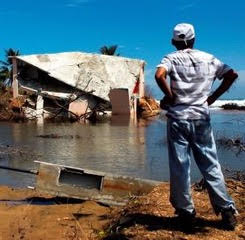 This week, as I was writing this letter, the Governor of Puerto Rico finally admitted that Hurricane Maria killed at least 1,400 people last year.
This week, as I was writing this letter, the Governor of Puerto Rico finally admitted that Hurricane Maria killed at least 1,400 people last year.
For 11 months, though, the government insisted that the death toll was only 64, though given the force of the storm and the humanitarian crisis that followed, that was plainly, painfully false.
When a government denies an obvious truth in the aftermath of a disaster, it prevents people from accurately measuring the scope of the damage. It denies them vital tools for recovery, both tangible, like insurance payouts, and intangible, like acknowledging their grief. It denies them their stories.
Last month, I wrote about the clichés that tend to pervade stories about disasters. (And I’ll be talking more about this subject in two weeks at the HippoCamp nonfiction conference — if see me there, please do say hi!)
This month, I want to talk about another one. It’s not nearly as egregious as Puerto Rico denying the true toll of Hurricane Maria, but it’s dishonest in its own way: The We-Will-Rebuild-Exactly-Like-Before-Or-Better story.
It’s appealing, to be sure. It speaks to our resilience as human beings. It looks at devastation and the daunting recovery facing survivors, and it says, hey, we can handle it.
But aside from being tired and overused, this story fails a couple of important tests: It’s just not specific enough, and worse, it’s not true.
As disasters become more frequent and more destructive—2017 broke records for rain, heat waves, wildfires, hurricanes, and floods—it’s going to be harder and harder to rebuild. Some communities may decide to shift neighborhoods away from the danger zones, lest they be destroyed all over again. Plus, disasters wipe out landmarks that can never be replaced. They re-shape landscapes. And they’re bloody expensive—last year’s toll cost $306 billion in the U.S. alone. More and more, rebuilding better than before will just be out of reach.
So if you write a novel that ends with the brave townspeople, a year after the flood, proudly admiring their perfectly restored community, it would be too implausible to be believed. And nonfiction writers who peddle it as a possibility should ask whether they’re perpetuating a myth, one destined to let readers down.
It’s noble to want to write something that honors humanity’s resilience, but to make it resonant, to make it really work, you want to skip the cheerleader-y boosterism and instead take a detailed, accurate inventory: What’s repairable? What can be saved? What’s gone for good? And what does that say about the shape of what’s to come?
To rely instead on the build-it-better cliché glosses over the hard choices a disaster recovery forces people to make. It hides change, and erases losses. It denies people their stories.

Kelly Caldwell
Dean of Faculty



Recently I participated in a memoir writing workshop at a senior center facility, where I noticed during the exchanging of our works in order to critic each other, that conflict was either diluted or completely missing. When I pointed this out in class, even the teacher’s reaction was a bit uninspiring. I loved how you used as an example hurricane Maria (which devastated Puerto Rico) in order to point out how writer’s try to lift people’s spirits by using over the top optimistic examples. For me, it doesn’t work, because I demand a lot from literature, and overstated wishful thinking or utopianism leaves me feeling empty. However, having said that, especially in Facebook or in Christmas cards, I’ve noticed that there are a lot of people who do enjoy this type of relief.